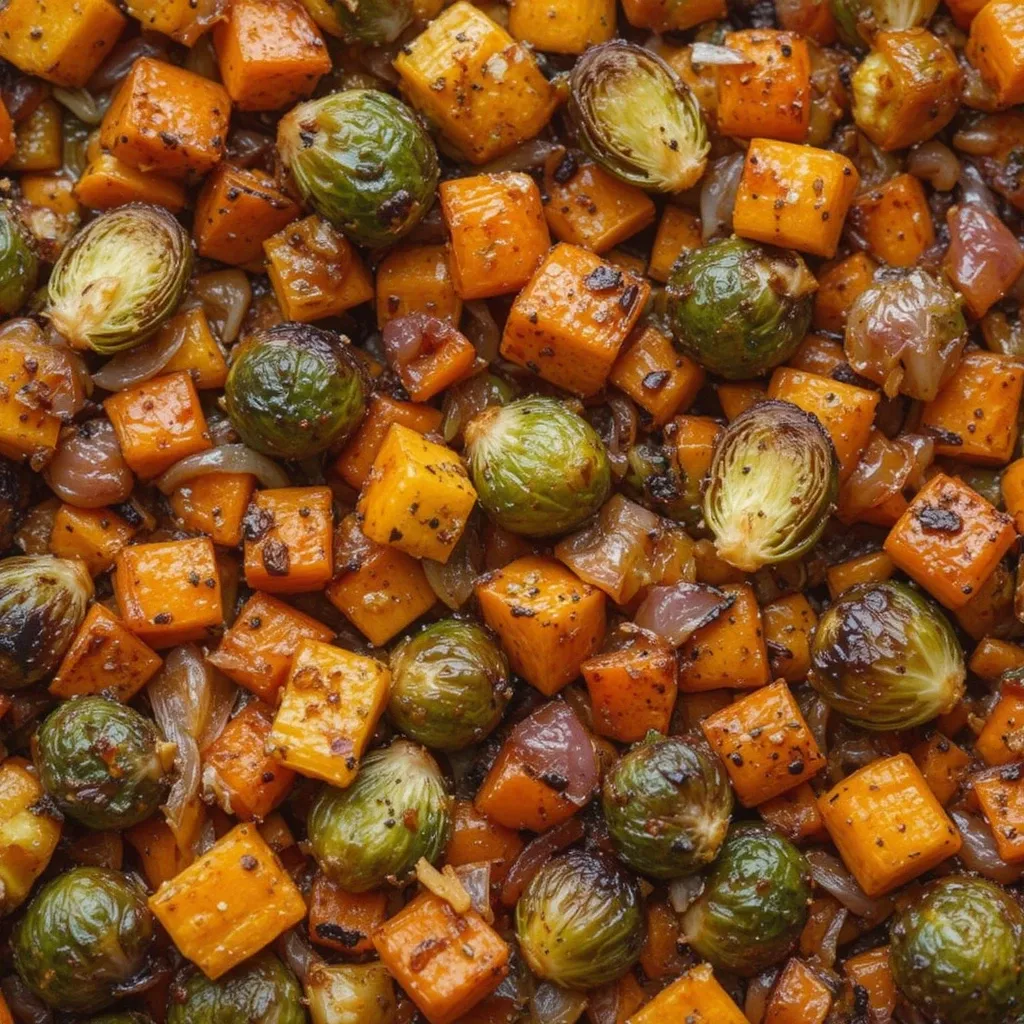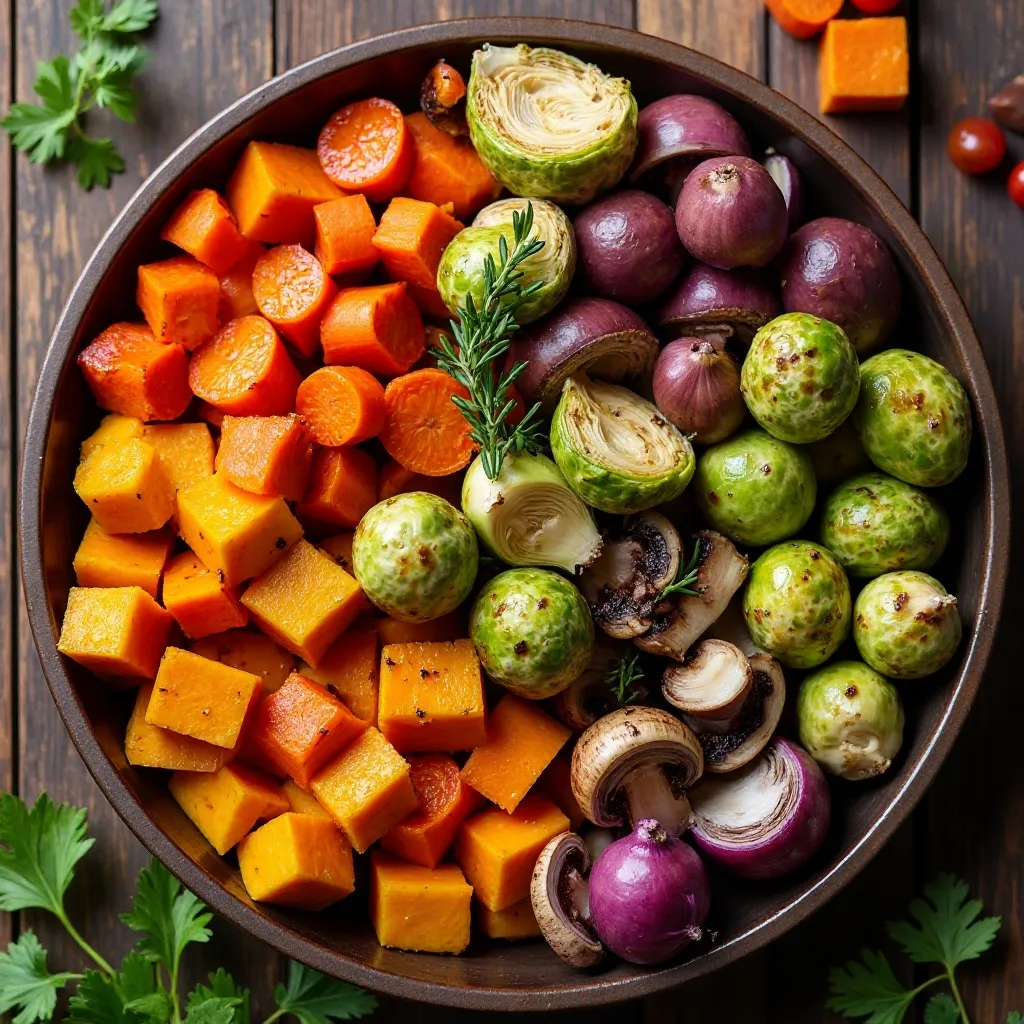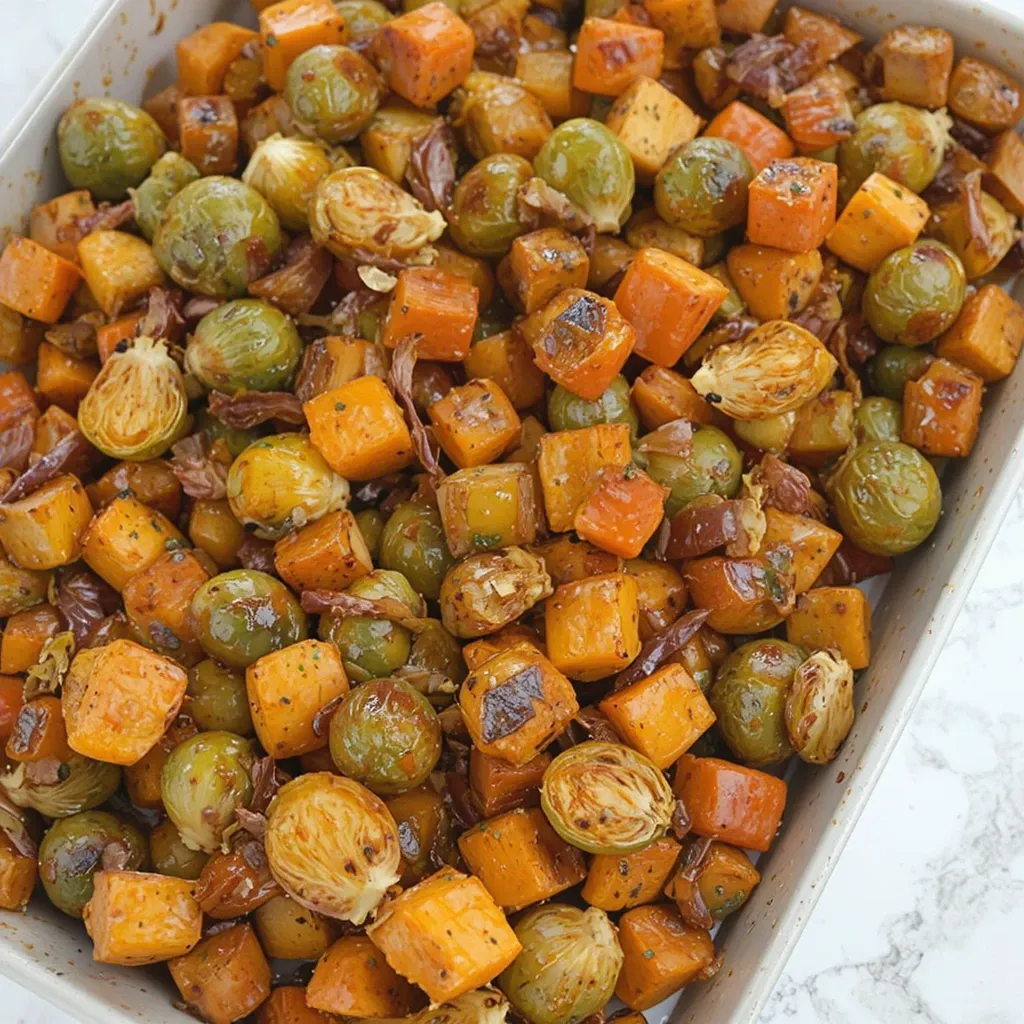Easy Roasted Vegetables for Thanksgiving – Everyone Asks for This Recipe
Picture this: golden-brown vegetables glistening with herbs, their caramelized edges releasing an irresistible aroma that fills your kitchen. These roasted vegetables for Thanksgiving are the perfect blend of simplicity and elegance, transforming humble produce into a show-stopping side dish.
Did you know that roasting vegetables at high heat caramelizes their natural sugars, creating flavors up to 40% more intense than other cooking methods? This dish proves that holiday cooking doesn’t need to be complicated to be spectacular.
In just 35 minutes, you’ll have a vibrant, nutrient-packed side that pairs beautifully with everything on your Thanksgiving table. Much like our popular Honey Glazed Carrots, this recipe delivers maximum flavor with minimal effort, making it ideal for busy holiday hosts. Get ready to discover why this colorful medley will become your new Thanksgiving tradition!
What is Roasted Vegetables for Thanksgiving?
Ever wonder why this dish has become a Thanksgiving staple across countless dinner tables? Roasted vegetables for Thanksgiving is simply a beautiful assortment of seasonal vegetables—think butternut squash, Brussels sprouts, carrots, and red onions—tossed with olive oil and herbs, then roasted until perfectly caramelized.
The name says it all: it’s vegetables, roasted to perfection, specifically chosen to complement your Thanksgiving feast. As the old saying goes, “the way to a man’s heart is through his stomach,” and these vegetables certainly know how to win hearts with their crispy exteriors and tender insides. Trust me, once you try this foolproof method, you’ll wonder why you ever steamed vegetables!

Why You’ll Love This Roasted Vegetables for Thanksgiving
The Ultimate Crowd-Pleaser: These roasted vegetables for Thanksgiving deliver on every level. The medley of colors—deep orange squash, vibrant green Brussels sprouts, and ruby-red onions—creates a stunning visual presentation that photographs beautifully and elevates your entire table setting. Each vegetable develops its own unique texture and flavor profile while harmonizing perfectly with the others.
Budget-Friendly Without Sacrificing Quality: Making roasted vegetables for Thanksgiving at home saves you significant money compared to pre-made sides or catering options. A tray that feeds 8-10 people costs under $15, using seasonal vegetables at their peak availability and affordability. You control the quality of ingredients, choosing organic options if desired, and avoid preservatives and excess sodium found in store-bought alternatives.
Customizable Flavor Combinations: The beauty lies in the toppings and seasonings. Fresh rosemary and thyme bring earthy, aromatic notes. A drizzle of balsamic glaze adds tangy sweetness. Crumbled feta or goat cheese provides creamy richness. Toasted pecans or walnuts contribute satisfying crunch.
The possibilities are endless, allowing you to customize based on dietary preferences or what’s in your pantry. Similar to our popular Garlic Parmesan Roasted Potatoes, this recipe welcomes creativity while maintaining foolproof results. Why settle for bland steamed vegetables when you can create this masterpiece at home?
How to Make Roasted Vegetables for Thanksgiving
Quick Overview
This roasted vegetables for Thanksgiving recipe is remarkably straightforward, requiring just basic knife skills and one large baking sheet. The vegetables roast together harmoniously, developing deep caramelization and complex flavors while you focus on other Thanksgiving preparations. The result is a satisfying side dish with crispy, golden edges and perfectly tender centers. Each vegetable maintains its distinct character while contributing to an overall symphony of flavors.
Total Time: 35-40 minutes
- Prep Time: 15 minutes
- Cook Time: 25 minutes
- Servings: 8-10 people
Key Ingredients for Roasted Vegetables for Thanksgiving
Vegetables:
- 2 pounds butternut squash, peeled and cubed (1-inch pieces)
- 1 pound Brussels sprouts, trimmed and halved
- 3 large carrots, peeled and cut into 1-inch pieces
- 1 large red onion, cut into wedges
- 8 ounces cremini mushrooms, quartered
- 1 red bell pepper, cut into 1-inch pieces
Seasonings & Herbs:
- ¼ cup extra virgin olive oil
- 3 cloves garlic, minced
- 2 tablespoons fresh rosemary, chopped
- 2 tablespoons fresh thyme leaves
- 1 teaspoon sea salt
- ½ teaspoon black pepper
- ½ teaspoon smoked paprika (optional)
Optional Finishing Touches:
- 2 tablespoons balsamic glaze
- ¼ cup crumbled feta or goat cheese
- ¼ cup toasted pecans
- Fresh parsley for garnish

Step-by-Step Instructions
Step 1: Preheat and Prepare
Preheat your oven to 425°F (220°C). This high temperature is crucial for achieving proper caramelization on your roasted vegetables for Thanksgiving. Line two large baking sheets with parchment paper or lightly grease them with cooking spray. Having two sheets ready ensures vegetables aren’t overcrowded, which is essential for roasting rather than steaming.
Step 2: Prep Your Vegetables
Begin with the butternut squash. Peel it using a sharp vegetable peeler, cut it in half lengthwise, scoop out the seeds, and cut the flesh into uniform 1-inch cubes. Consistency in size ensures even cooking. Trim the Brussels sprouts by cutting off the stem ends and removing any yellow outer leaves, then slice them in half lengthwise. Peel and cut carrots into similar-sized pieces. Cut the red onion into wedges, keeping some of the root end intact so wedges hold together. Quarter the mushrooms and dice the bell pepper.
Step 3: Season and Toss
Place all prepared vegetables in a large mixing bowl. This is where the magic begins for your roasted vegetables for Thanksgiving. Drizzle the olive oil over the vegetables, ensuring even distribution. Add minced garlic, chopped rosemary, thyme leaves, salt, pepper, and smoked paprika if using. Using clean hands or two large spoons, toss everything together thoroughly. Every piece should glisten with oil and be lightly coated with herbs. This step takes 2-3 minutes but makes all the difference in flavor.
Step 4: Arrange on Baking Sheets
Divide the seasoned vegetables between your two prepared baking sheets. Spread them in a single layer, ensuring pieces don’t overlap or crowd. Leave space between vegetables—about ½ inch if possible. Crowding causes steaming instead of roasting, resulting in soggy vegetables. If needed, use a third baking sheet. Place harder vegetables like carrots and squash toward the edges where heat is most intense.
Step 5: Roast to Perfection
Place both baking sheets in the preheated oven. If your oven accommodates both sheets on the same rack, position them side by side. Otherwise, place one on the upper third and one on the lower third, planning to rotate them halfway through cooking. Roast for 25-30 minutes total. At the 15-minute mark, remove the pans and use a spatula to flip and stir the vegetables. This ensures even browning on all sides. Rotate the pans’ positions if using two oven racks.
Step 6: Check for Doneness
Your roasted vegetables for Thanksgiving are ready when edges are deeply caramelized and golden brown, and a fork pierces the squash and carrots easily. Brussels sprouts should have crispy, charred outer leaves. If some vegetables finish before others, remove them and let the rest continue cooking. Timing varies based on your oven and how vegetables were cut.
Step 7: Add Finishing Touches
Transfer roasted vegetables to a serving platter while still hot. Drizzle with balsamic glaze if using, creating an artistic zigzag pattern. Sprinkle with crumbled feta or goat cheese, allowing it to slightly melt from the heat. Add toasted pecans for crunch. Garnish with fresh parsley. These final touches transform good roasted vegetables into spectacular ones worthy of your Thanksgiving table.
What to Serve Roasted Vegetables for Thanksgiving With
These roasted vegetables for Thanksgiving are incredibly versatile and complement virtually any holiday main dish:
Main Courses: Pair beautifully with roasted turkey, honey-glazed ham, herb-crusted prime rib, or maple-glazed salmon for a lighter option. The vegetables’ natural sweetness balances savory proteins perfectly.
Other Thanksgiving Sides: Serve alongside creamy mashed potatoes, traditional stuffing, green bean casserole, and cranberry sauce. The roasted vegetables add freshness and color to heavier, cream-based sides.
Grain-Based Sides: Complement with wild rice pilaf, quinoa salad, or crusty dinner rolls. The combination creates a well-rounded, satisfying meal.
Beverages: Pair with crisp white wines like Sauvignon Blanc or Chardonnay, light red wines such as Pinot Noir, sparkling apple cider for non-alcoholic options, or herbal teas.
Dessert Transition: These vegetables’ natural sweetness prepares the palate nicely for traditional Thanksgiving desserts like pumpkin pie, apple crisp, or pecan pie.

Top Tips for Perfecting Roasted Vegetables for Thanksgiving
Tip 1: Size Matters for Even Cooking
Cut all vegetables into uniform 1-inch pieces. This ensures everything finishes cooking simultaneously. Harder vegetables like carrots and squash can be slightly smaller if you’re concerned about cooking time.
Tip 2: Don’t Skimp on Oil
Adequate oil coating is essential for caramelization. Use the full ¼ cup even if it seems generous. Oil conducts heat, helping vegetables brown rather than dry out. For lighter options, use avocado oil spray, though results won’t be quite as rich.
Tip 3: Temperature is Critical
Never roast below 400°F for this recipe. High heat (425°F) creates the Maillard reaction—the chemical process responsible for that delicious brown crust and complex flavors. Lower temperatures steam vegetables instead.
Tip 4: Give Vegetables Space
Overcrowding is the number one mistake when making roasted vegetables for Thanksgiving. Vegetables release moisture as they cook. Without space, moisture traps, creating steam. Use multiple pans if necessary.
Tip 5: Timing Adjustments for Different Vegetables
Not all vegetables roast at the same rate. If adding delicate vegetables like zucchini or asparagus, add them 10 minutes into cooking. For extra-crispy Brussels sprouts, add them 5 minutes before other vegetables finish.
Tip 6: Fresh Herbs vs. Dried
Fresh herbs provide superior flavor for roasted vegetables for Thanksgiving. If substituting dried herbs, use one-third the amount (dried herbs are more concentrated). Add dried herbs before roasting; add delicate fresh herbs like parsley after roasting.
Tip 7: Make-Ahead Strategy
Prep vegetables up to 24 hours ahead. Store cut, unseasoned vegetables in airtight containers with damp paper towels. Season and roast just before serving for best results. This saves precious Thanksgiving Day time.
Tip 8: Reviving Leftovers
Leftover roasted vegetables make excellent additions to omelets, grain bowls, or sandwiches. Reheat in a hot skillet rather than microwave to restore some crispness.
Storing and Reheating Tips
Refrigerator Storage:
Allow roasted vegetables for Thanksgiving to cool completely before storing. Transfer to airtight containers, separating different layers with parchment paper if stacking. Store in the refrigerator for up to 4 days. Glass containers work best as they don’t absorb odors or colors.
Freezer Storage:
While roasted vegetables can be frozen, texture changes slightly upon thawing. For best results, freeze in single-layer portions on baking sheets until solid, then transfer to freezer bags, removing excess air. Label with the date and use within 3 months. Note that Brussels sprouts and mushrooms don’t freeze as well as harder vegetables.
Reheating Methods:
The best way to reheat and maintain texture is in a hot oven. Spread vegetables on a baking sheet and reheat at 400°F for 8-10 minutes until heated through and edges crisp up. Alternatively, reheat in a skillet over medium-high heat with a small amount of oil, stirring occasionally. Avoid microwaving if possible, as it makes vegetables soggy. If you must microwave, use 50% power and heat in 30-second intervals.
Meal Prep Applications:
These roasted vegetables for Thanksgiving work wonderfully for meal prep. Portion into individual containers with proteins and grains for complete meals. They maintain quality for 3-4 days, making them perfect for post-Thanksgiving lunches.
Tips for Avoiding Common Mistakes
Mistake 1: Vegetables Turn Out Soggy
This happens when vegetables are overcrowded, oven temperature is too low, or vegetables weren’t dried properly after washing. Always pat vegetables completely dry with paper towels before seasoning. Moisture is the enemy of crispiness.
Mistake 2: Uneven Cooking
Results from inconsistent cutting sizes. Take extra time ensuring uniform pieces. Start with vegetables that take longer to cook (like carrots and squash) and add quicker-cooking vegetables partway through if needed.
Mistake 3: Burnt Edges, Raw Centers
Indicates oven hot spots or temperature too high. If your oven runs hot, reduce temperature to 400°F and increase cooking time by 5-10 minutes. Rotate pans more frequently—every 10 minutes instead of once.
Mistake 4: Bland Flavor
Usually means insufficient seasoning or oil. Don’t be afraid to season generously. Vegetables absorb a lot of seasoning. Taste a piece at the 20-minute mark and adjust if needed. Remember, you can always add more seasoning after roasting.
Mistake 5: Vegetables Stick to Pan
Prevent by using parchment paper or adequately greasing pans. If vegetables do stick, let them continue cooking—once fully caramelized, they release more easily. Patience is key.
Mistake 6: Forgetting to Flip
Vegetables that aren’t flipped develop one perfect side and one pale side. Set a timer for the halfway point to ensure you don’t forget this crucial step.
Frequently Asked Questions
Can I make roasted vegetables for Thanksgiving ahead of time?
Yes! You can prep vegetables up to 24 hours in advance. Store cut, dry vegetables in airtight containers in the refrigerator. Don’t add oil and seasonings until just before roasting. Alternatively, roast vegetables completely up to 2 hours before serving and keep warm in a 200°F oven, though they won’t be quite as crispy.
What vegetables work best for roasting at Thanksgiving?
The best vegetables for roasted vegetables for Thanksgiving include butternut squash, Brussels sprouts, carrots, parsnips, sweet potatoes, red onions, cauliflower, and beets. Choose a variety of colors and textures. Avoid high-moisture vegetables like tomatoes and zucchini unless you’re comfortable with their different cooking times.
How do I prevent vegetables from burning?
Use parchment paper on baking sheets, don’t exceed 425°F, ensure even oil coating, and flip vegetables halfway through cooking. If edges start browning too quickly, tent loosely with foil for the final 5 minutes. Every oven is different, so adjust accordingly.
Can I use frozen vegetables for this recipe?
Fresh vegetables work best for roasted vegetables for Thanksgiving. Frozen vegetables contain excess moisture that prevents proper caramelization. If you must use frozen, thaw completely, pat extremely dry with paper towels, and expect slightly different texture results.
What’s the best oil for roasting vegetables?
Extra virgin olive oil provides excellent flavor for roasted vegetables for Thanksgiving. Avocado oil works well for those avoiding olive oil and has a higher smoke point. Coconut oil can be used but imparts coconut flavor. Avoid butter alone as it burns easily at high temperatures.
How do I make roasted vegetables crispy?
High heat (425°F), adequate oil coating, proper spacing on pans, and flipping halfway through are essential. Make sure vegetables are completely dry before oiling. Don’t cover vegetables while roasting, as trapped steam creates sogginess.
Can I make this recipe vegan or gluten-free?
This roasted vegetables for Thanksgiving recipe is naturally vegan and gluten-free when you omit cheese toppings. For vegan cheese alternatives, try nutritional yeast for umami flavor or dairy-free feta. All main ingredients are plant-based and gluten-free.
What if I don’t have fresh herbs?
Substitute dried herbs using one-third the amount. For this recipe, use 2 teaspoons dried rosemary and 2 teaspoons dried thyme. Mix dried herbs with oil before tossing with vegetables. Fresh herbs provide better flavor, but dried work in a pinch.
How many people does this recipe serve?
This recipe serves 8-10 people as a side dish. Each serving is approximately 1 cup. For larger gatherings, recipe easily doubles or triples. Just ensure you have enough baking sheets and oven space to maintain proper spacing.
Can I add sweet potatoes to the mix?
Absolutely! Sweet potatoes make excellent additions to roasted vegetables for Thanksgiving. Cut them into 1-inch cubes and add with other vegetables. They roast at a similar rate to butternut squash. Their natural sweetness complements the savory herbs beautifully.
Nutrition Information
| Nutrient | Amount Per Serving |
|---|---|
| Serving Size | 1 cup (approximately 150g) |
| Calories | 145 |
| Total Fat | 7g |
| Saturated Fat | 1g |
| Cholesterol | 0mg (without cheese) |
| Sodium | 295mg |
| Total Carbohydrates | 20g |
| Dietary Fiber | 5g |
| Sugars | 7g |
| Protein | 4g |
| Vitamin A | 180% DV |
| Vitamin C | 85% DV |
| Calcium | 6% DV |
| Iron | 12% DV |
Note: Nutrition information is approximate and based on recipe without optional toppings like cheese or nuts.
Final Thoughts
These roasted vegetables for Thanksgiving represent everything a holiday side dish should be: beautiful, flavorful, nutritious, and remarkably simple to prepare. The combination of caramelized edges, tender centers, and aromatic herbs creates a dish that complements your Thanksgiving feast while standing proudly on its own merits.
The beauty of this recipe lies in its flexibility. Customize vegetables based on what’s freshest at your market or what your family loves most. Experiment with different herb combinations, try various finishing touches, and make this recipe your own signature dish.
Whether you’re hosting Thanksgiving for the first time or you’re a seasoned holiday chef looking for reliable recipes, these roasted vegetables will quickly become a tradition. They’re approachable enough for beginners yet sophisticated enough to impress the most discerning guests.
This Thanksgiving, let your vegetables shine. Transform simple produce into a stunning centerpiece that celebrates the season’s bounty. Your guests will be asking for this recipe before dessert is served.
Happy Thanksgiving, and happy roasting!
